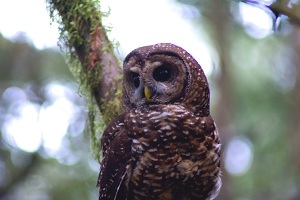Introduction
 Northern spotted owl. CDFW photo by Margaret Mantor.
Northern spotted owl. CDFW photo by Margaret Mantor.
The northern spotted owl is one of three subspecies of spotted owl.The other two subspecies are California Spotted Owl (Strix occidentalis occidentalis) and Mexican Spotted Owl (Strix occidentalis lucida).In 2016, the California Fish and Game Commission approved listing the Northern Spotted Owl (Strix occidentalis caurina) as Threatened (PDF) under the California Endangered Species Act. It has been listed as Threatened under the federal Endangered Species Act since 1990.
Distribution and Abundance
The range-wide distribution includes British Columbia through the Cascade Range, coastal ranges, and intervening forested lands in Washington, Oregon, and northern California, as far south as Marin County. The southeastern boundary of its range is the Pit River area of Shasta County, California. No range-wide estimate for abundance exists because survey methods and effort conducted to date do not provide for reliable estimation of population size across the range.
Biology
The Northern Spotted Owl is dimorphic in size, with females typically weighing 10 to 20 percent more than males. Northern Spotted Owls do not build their own nest, but instead seek out naturally occurring nest sites such as broken-top trees, tree cavities, mistletoe brooms, debris accumulations, or nests built by other wildlife (e.g., abandoned raptor nests, squirrel nests). Reproduction often occurs once every other year. Females usually lay one to two eggs in late March through April, but timing can vary by latitude and elevation. Chicks generally leave the nest in late May or in June (at 34-36 days old) and continue to be dependent on their parents into September.
Generally, older forests with a higher degree of complexity and a high canopy closure are thought to be preferred for nesting and roosting activities. Along the coast, these same components can be found in younger forests that have a higher regrowth potential. Structural components of high quality spotted owl habitat include a multilayered, multispecies canopy, large conifer overstory trees, shade-tolerant understory conifers or hardwoods, moderate to high canopy closure, live coniferous trees with deformities (e.g. cavities, broken tops, mistletoe infections), large snags, and large logs and other woody debris in the groundcover.
Within the northern portion of the owl’s range (much of Washington and Oregon) flying squirrels are the main component of the diet. In the southern portion of the range (California and parts or Oregon) dusky-footed woodrats are the main component of the diet. Other prey include deer mice, tree voles, red-backed voles, shrews, gophers, snowshoe hare, rabbits, bushy-tailed woodrats, chipmunks, small to medium sized birds, bats, and insects.
Threats
As outlined in the Department's Status Review for Northern Spotted Owl (PDF), the primary threats to the continued existence of Northern Spotted Owl in California are the rapid expansion of a novel competitor, the Barred Owl, a rapid and accelerating decline in population size and demographic rates (e.g., survival, reproduction, occupancy), and loss of habitat due to wildfire and timber harvest. Additional threats include increases in frequency and severity of wildfires, widespread occurrence of marijuana cultivation on public and private lands, shifts in weather patterns related to climate change, effects of climate change on wildfire patterns and forest vegetation distribution, and the spread of the non-native fungus-like pathogen responsible for Sudden Oak Death Syndrome.
Population Status and Trend
Northern Spotted Owl populations are declining throughout the range of the subspecies and annual rates of decline have been accelerating in many areas, including in California. Population sizes within three large study areas in California have declined 31-55% since the 1990s and these declines are accelerating. The ongoing and increasing effects of Barred Owls, coupled with other threats including habitat loss due to wildfire and timber harvest, and reduced recruitment due to climate change, will likely lead to additional declines into the future.
Submission of Northern Spotted Owl Data
CDFW manages the Spotted Owl Observations Database (SPOWDB) and a supplemental barred owl dataset. You can submit data to these databases by sending it directly to owlobs@wildlife.ca.gov. Data entry templates are available upon request.
You may also submit data using the CNDDB Online Field Survey Form. This form is an internet application that allows users to map an observation of a rare species, including but not limited to spotted owls, and submit the location and associated data in a single step. First time users will need to set up an account but will not need a CNDDB subscription to submit data.
The SPOWDB now has a management framework (PDF). This document provides background information about the SPOWDB and the process for receiving and symbolizing spotted owl data.
CDFW
External